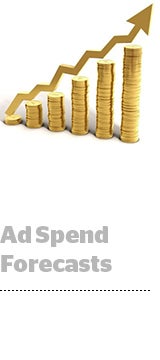GroupM, Magna and Zenith released global ad spend forecasts on Monday, and all agree that 2020 was not the catastrophe many had predicted.
Disaster was averted in large part due to the accelerated shift to digital during the pandemic.
Global advertising fell by 5.8% in 2020, according to GroupM, which “could have been worse” and only represents a mild setback.
In June, GroupM predicted an 11.9% decline in global advertising. Based on its newly revised figures, however, media owners will generate $591 billion in advertising revenue and see “meaningful improvement” next year, rebounding by 12.3% to $649 billion (minus political ad spending).
Magna, meanwhile, found that total global ad revenue for both linear and digital shrank by 4.2% to $569 billion, a “milder” decline than it had forecasted in June. Digital media, which according to Magna grew 8% to $336 billion, accounting for 59% of all advertising transactions, was “particularly resilient,” said Vincent Letang, EVP of global market intelligence at Magna.
Three markets in particular – China, the Unites States and the United Kingdom – benefited disproportionately from the growth of ecommerce and related advertising.
“It was pretty clear at the end of the second quarter that things weren’t as bad as we thought,” said Brian Wieser, GroupM’s global president of business intelligence.
Digital, digital, digital
Global advertising in 2020 was buoyed by digital video consumption and a boom in ecommerce as brick-and-mortar shops were shut down, travel came to a screeching halt and many consumers stayed indoors during the height of the pandemic.
GroupM expects digital advertising to grow by 8.2% in 2020 to $343 billion, excluding political advertising. This growth will be driven by ongoing ecommerce activity and by small businesses increasing their online presence and upping their digital ad spending. That number will grow by 15.4% to $396 billion in 2021.
Pure-play digital media owners, including Amazon, Facebook and Google, have been (surprise, surprise) the biggest beneficiaries of the shift to digital and will collectively capture 61% of all advertising dollars next year.
This uptick was already apparent in both Facebook and Google’s respective Q2 earnings results, Wieser said.
“But the degree to which it continued was pretty profound,” he said.
In addition to goings on at the platforms, large marketers in categories that were able to continue operating during the pandemic were mostly able to keep their budgets intact, and that money flowed into ecommerce which in turn led to more spending on digital media.
And digital spending also saw a boost from the 2020 election. Out of the more than $6 billion spent on political advertising, $1.5 billion went toward digital media this year, three times more than in 2018.
“For us it’s the first time that digital media gets a realistic share of political dollars,” Letang said.
Slowdown not so fast
Although this year marked a significant slowdown in the rate of growth for digital ad spending compared to the past five years, when it averaged 18% growth annually, Letang called attention to its continued strength during COVID-19.
“We were expecting digital growth to slow down significantly simply out of maturity, having reached 50% of total advertising spending,” he said. “It was always predicted to slow down, so that resilience surprised even us.”
Social had also shown signs last year that it was plateauing, and even slightly declining for some platforms. But there was growth there too.
“It had reached a point in terms of penetration and time spent [where] it was impossible to go further,” Letang said. “Well, it reaccelerated this year.”
Tuning in
And so did digital video consumption, although that’s hardly a surprise, Letang said. And with increased consumption came an increase in the volume of advertising impressions.
“Although pricing was probably down,” he said, “the volume grew so much it meant double-digit growth for social media and digital video.”
Linear advertising sales, on the other hand – traditional TV, radio, print and out-of-home – suffered mightily in 2020 with full-year sales declining by an estimated 16% to $81 billion.
Although traditional television got a boost in ratings during the early days of the pandemic – mostly coming from news channels – that trend didn’t last in the United States compared to other markets, such as Italy, Letang said.
And as ad-supported connected TV continues to grow, it will keep on eating away at traditional TV. Total TV advertising will drop 15% this year before rebounding to grow nearly 8% next year, according to GroupM, while digital extension and related media are expected to fare much better, with 7.8% growth this year and 23% growth in 2021.
“Budgets do not necessarily flow across media because audiences shift how they spend their time,” Wieser said. “[But] CTV is TV – money will flow inside of television based, generally speaking, on where audiences are inside of the medium.”
According to Zenith, demand for ad-funded video on demand was particularly strong this year. Between January and April, the reach of subscription VOD services in the United States rose by 5% while the reach of AVOD rose by 9% to 58.5 million households.
Looking ahead
But what about the potential impact on digital ad spending as a result of privacy regulations, such as GDPR and CCPA?
“Those regulations, and the gradual phasing out of cookies, is in fact penalizing publishers more than it affects large platforms with tons of first-party data,” Letang said. “The big guys are faring better than independent platforms or publishers this year.”
But everyone should benefit from the widescale vaccinations set to roll out in the first half of the year, according to Magna, and as restrictions gradually lift, “global economic activity should recover strongly,” Letang said.
Global ad spend is expected to jump 7.6% to $612 billion, above Magna’s previous forecast of 1.5%. Linear media is expected to stabilize with a 3.5% increase, while digital media will reaccelerate to double-digit growth at 10.4%.
The entertainment and restaurant industries will benefit from gradual reopenings, while food and drinks brands will benefit from a return to normal sports schedules and social interactions, Letang said. The auto and travel industries, however, will remain financially fragile.
“It’s fair to say that it’s an optimistic scenario when there’s a risk that vaccinations may be delayed or parts of the population could refuse it and prolong the COVID issues,” Letang said. “With several vaccines ready to get distributed, I suspect some countries are going to do a better job than others.”















